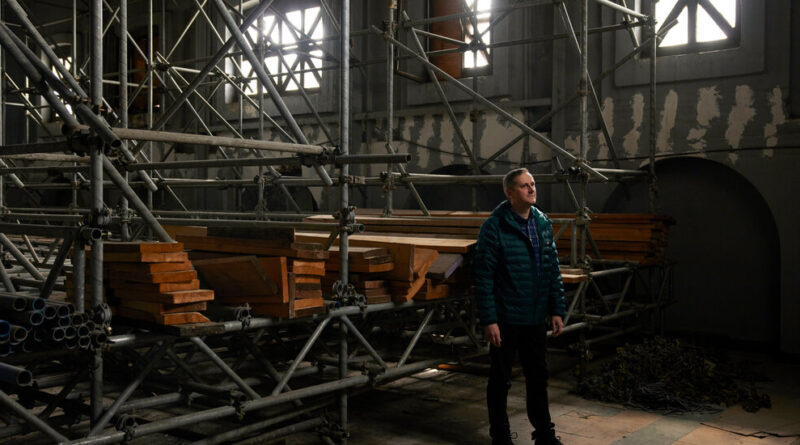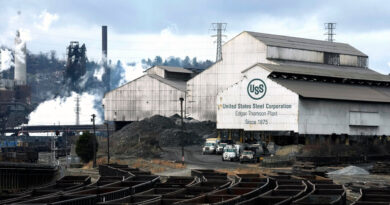Can He Fix ‘Palace of Scaffolding’ in Time for Belgium’s 200th Birthday?
[ad_1]
It was love at first sight.
More than 10 years ago, André Demesmaeker, an architect for the Belgium government, was asked to investigate a ceiling collapse at the Palace of Justice, a 19th-century behemoth in the heart of Brussels that houses the country’s sprawling judiciary system and has been falling apart for decades.
“I opened a door not seen in ages,” Mr. Demesmaeker recalled recently. “I entered this attic and had to start climbing to explore.”
On that — and later visits to the immense building — Mr. Demesmaeker discovered a warren of rooms and anterooms, some occupied by lawyers or judges, others abandoned and moldering. The floors, roof and walls were falling apart. Water had seeped inside, so fungus grew abundantly. Homeless people sometimes broke in to sleep and booze it up alongside piles of archived legal files. Many corridors reeked of alcohol and urine.
Some rooms looked frozen in time: old magazines, a coat, a coffee pot. As if the people working there had simply vanished one morning.
At that time, in 2010, the building had been under restoration since 1984, so long that the scaffolding surrounding it had failed, requiring its own renovation. Some called the building “the Palace of Scaffolding.”
But where others saw an eyesore and a bureaucratic nightmare, Mr. Demesmaeker saw beauty, a treasure trove of history’s secrets.
Four years later, Mr. Demesmaeker, now 52, was put in charge of overseeing the restoration of the colossal stone facade. The scaffolds have been refurbished, and are expected to come down soon; construction on the facade is about to begin. Work on the vast interior, overseen by other officials, is just now being discussed. He hopes the renovation of the exterior is complete by 2030, in time for Belgium’s bicentennial celebration.
Mr. Demesmaeker, who hunches his shoulders forward shyly or makes jokes when talking about himself or his work, is not daunted by the burden of what is a nearly 40-year renovation job. He couldn’t hide his excitement the other day as he led a two-hour expedition through 20 or so rooms like an explorer seeking lost riches.
“That’s what I love: trudge, crawl, search, investigate,” he said with fizzy eyes, as he swirled sets of spiraled stairs to examine the roof gutters.
Opened in 1883, the palace was once the world’s largest building. Today it covers nine square blocks in downtown Brussels and stands as a crumbling monument to Belgium’s notorious bureaucracy.
The country has three official languages (Flemish, French and German); six parliaments (a federal one and five regional bodies representing different constituencies); more than a dozen political parties; and a separatist movement. Its politics are so fragile that at times it has gone nearly two years without a functioning national government.
Mr. Demesmaeker’s job, then, would seem ideal for a master bureaucrat, a multilingual charmer who could deftly navigate the political forces that want to push his project forward or swipe his budget.
Mr. Demesmaeker, by his own admission, is not that.
He admitted to not being particularly good at languages and said he was often as boggled as anyone about layers of government. Separated with two sons, he speaks of himself as a homebody. “I was born in Brussels. I grew up in Brussels, and with some luck, I might even die in Brussels,” he said.
As a teenager, he wanted to be a pharmacist but didn’t want to be stuck in a lab. He gravitated to architecture because he liked the idea of being outside, on building sites.
He always loved unlocking mysteries, what he called the how-and-why of things. “My dad would buy a new radio. I would take it apart,” he said.
He began his career as a freelance architect, but at 29, for more career stability, he joined the Belgian Buildings Agency, which manages all state-owned property and is responsible for preserving buildings of historical note.
Mr. Demesmaeker has never before given an interview. On the recent palace visit, at times he leaned forward into a reporter’s recording device, enunciating his talking points. More often, though, he blushed and whispered confessions — as when he said he can’t explain why the palace restoration has taken so long.
General red tape is one factor. Two long stretches without a government did not help. One former building agency official was arrested on corruption charges. The company that erected the scaffolding went bankrupt. And the buildings agency has bounced between ministries during various government reorganizations.
Jean-Pierre Buyle, the chairman of the Poelaert Foundation, which campaigns to preserve the building, said the ministers critical to the project’s success have often come from the Flanders region and have little interest in financing a project in Brussels.
Mr. Demesmaeker considers the project the job of a lifetime, a reference perhaps to the building’s original architect who died several years before the palace was completed.
But he stays focused on the immediate challenges.
Because the palace is in the city’s center, there’s only so much space to work, which means only one of the four facades can be restored at a time. Each takes about two years, a timeline that can outlast budgets and political will.
Every step requires conversations and compromises with the judges and administrators of several different courts, including the Belgian supreme court and the country’s highest criminal court — plus the French- and Flemish-speaking lawyers who sometimes do not even want to share the building’s library.
Mr. Demesmaeker has one quality that experts say make him perfect for this moment — his love for the building.
“This monument has suffered greatly from a lack of love,” Mr. Buyle said.
In particular Mr. Demesmaeker loves the layered, parallel universes of the palace. The public sees the courtrooms and other public spaces, like the Hall of Lost Footsteps, the main public hall, lavishly decorated with dainty tapestries, porcelain vases and ivory cabinets. But just a few meters above sits another hall, once used to train police officers, now empty save for a few fading posters of martial artists and a row of cracked showers.
Mr. Demesmaeker has rescued many objects that workers have consigned to the trash heap. A graffiti-tagged stone. Pieces of wood. A plaque reading “No Lawyers Allowed.” He saves them in collections of other interesting debris that he keeps in his home or in his office.
His sons have begged him to stop collecting, but during the recent visit to the palace, it was clear he can’t help himself. He eyed a lonely old tire among the debris.
“I have been thinking about it for my collection,” he said.
The clock is ticking, but the list of what needs to be done keeps growing. An ecosystem of butterfly bushes and elderberries has taken root inside the stone walls and must be removed. Graffiti needs soaping. Another ceiling recently collapsed.
Can Mr. Demesmaeker make his deadline of 2030? He leaned in close, speaking into the recorder: “I just hope to finish before retirement.”
[ad_2]
Source link



